Samsung Galaxy S8 Showdown: Exynos 8895 vs. Snapdragon 835, Performance & Battery Life Tested
by Matt Humrick on July 28, 2017 8:00 AM EST- Posted in
- Smartphones
- Samsung
- Galaxy
- Mobile
- SoCs
- Snapdragon 835
- Exynos 8895
- Galaxy S8
Battery Life
When Samsung introduced the Galaxy S7 last year, we were happy to see a larger 3000 mAh (11.55 Wh) battery inside, a significant increase over the 2550 mAh (9.81 Wh) unit inside the Galaxy S6. There is no further capacity increase this year, however. The S8 retains the same 3000 mAh (11.55 Wh) battery, which is the same capacity found in the HTC U11. The LG G6, perhaps the S8’s closest competitor, comes with a larger 3300 mAh (12.54 Wh) unit, which could help keep it running a little longer.
To see how Samsung’s two SoC choices affect the S8’s battery life, and see how it stacks up to its competitors, we’ll run it through our standard suite of battery tests. To make the tests accurate and repeatable, we control as many variables as possible, including minimizing background tasks and calibrating each display to 200 nits at 100% APL. All of the Android phones in the charts below except for the S7 (E8890) have all available software updates applied and are running the same version of Chrome.
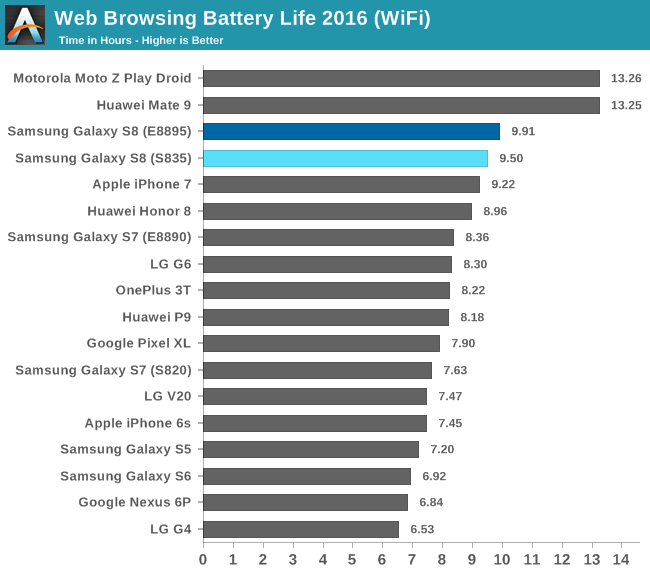
The Galaxy S8 does quite well in our Wi-Fi browsing test that loads, pauses, and then scrolls through a set of popular websites while connected to Wi-Fi with the cellular radio turned off. We do not see much difference in runtime (only 25 minutes or 4%) between the E8895 version and the S835 version here, mainly because this workload does not utilize the big CPU cores that much, and the display tends to be the greatest power consumer in this scenario. Shutting down just shy of the 10 hour mark, the S8 outlasts the iPhone 7 by either 17 or 41 minutes, a noteworthy accomplishment considering the S8 uses a larger AMOLED display that needs to cope with relatively high APL web content (lots of white backgrounds). The S8 (S835) also lasts nearly 1.25 hours longer than the LG G6 (S821), despite the latter phone having a bigger battery.
Of the two Exynos powered Galaxies, the E8895 S8 lasts 1.5 hours longer than the E8890 S7. The E8890 is hardly the most power efficient SoC, so this likely accounts for some but not all of the difference. The gap between the Snapdragon Galaxies is even bigger, with the S835 S8 browsing for 1.9 hours longer than the S820 S7.
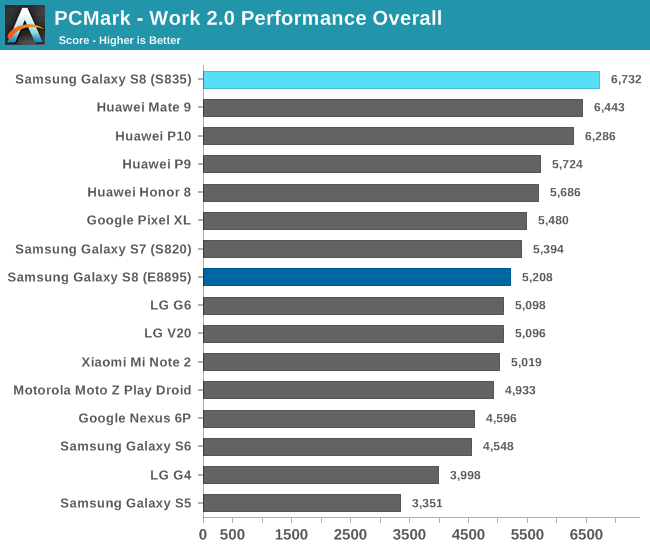

PCMark’s mixed workloads exercise the CPU, GPU, storage, and memory subsystems, giving us a more complete evaluation of battery life. Huawei’s Mate 9 runs longer than the S8 because of its larger 4000 mAh battery, but the S8 actually does quite well, with no appreciable difference in runtime between the two S8 models. Unfortunately, I was not able to take accurate power measurements, so we can only use average platform power consumption over the duration of the test for comparison, but the S8, regardless of SoC choice, uses considerably less power than the S5, S6, or S7 (S820). After factoring in overall PCMark performance, the S8 (S835) has the highest average efficiency of any device in this chart—about 24% better than the S8 (E8895). In the Wi-Fi Web browsing test, we saw very little difference between the two SoCs under a relatively light CPU load. The S8 (S835) manages to distinguish itself in PCMark primarily because of its more efficient GPU (Photo/Video Editing tests), which did not factor into the Wi-Fi browsing results. While not as efficient as the S835 version or the Mate 9 and its Kirin 960 SoC, the S8 (E8895) is still better than the LG G6 and the older Galaxy phones.
The S8’s settings menu offers a choice between several preset performance modes that affect sound quality, screen brightness, and screen resolution, among other things. For the results shown in the charts above, the S8s used the default “Optimized” setting that reduces the screen resolution to FHD+ (2220x1080). Running the PCMark battery test at its highest WQHD+ (2960x1440) setting has no appreciable affect on battery life, however, regardless of SoC.


Note: Both Galaxy S8 models use the default FHD+ (2220x1080) resolution setting in this test
In the GFXBench Manhattan 3.1 battery life test, which predicts runtime while playing games, there’s a significant disparity between the S8’s two SoCs. The S835 S8 lasts about an hour longer than the E8895 S8, even though both deliver nearly identical steady-state performance during most of the test. Using the average platform power to calculate efficiency (performance per watt) after the two phones reach steady-state shows the S835 S8 with a 39% advantage over the E8895 S8. Our E8895 example does seem to have a poor bin for both the CPU and GPU, an issue that seems fairly common with the early batch of 10nm SoCs, which likely skews the results somewhat, but it cannot account for this large of a gap.
This is the second SoC example we’ve seen using ARM’s Mali-G71 GPU—the first being HiSilicon’s Kirin 960—and performance per watt is disappointing for both in workloads that really stress the GPU. The GPU configurations are significantly different too: The Kirin 960 uses 8 cores running at up to 1037MHz on TSMC’s 16nm FFC process, while the Exynos 8895 uses 20 cores running at up to 546MHz on Samsung’s 10nm LPE process. Without more detailed data, this is just an interesting observation rather than a definitive statement about the G71’s or E8895’s power consumption.
While the E8895 S8’s battery life in this test falls within the 3-3.5 hour average for flagship phones, the S835 S8’s 4.1 hour mark is pretty impressive. It’s certainly not the longest lasting, but the phones that run longer deliver lower performance. For example, the S8 (S835) offers double the sustained performance of either S7 model while lasting 20 minutes longer. The Galaxy S6 outlasts the S8 (S835) by a slim margin but only because it throttles back performance so severely.
GPU Thermal Stability
The E8895 S8 achieves better peak performance than the S835 model initially, but begins to throttle back the GPU frequency just shy of 5 minutes to stay within its thermal limits. The S835 S8 maintains peak performance for about 13 minutes before throttling. Interestingly, both S8 models deliver the same performance after reaching steady-state 21 minutes into the test. The E8895 model consumes more power (and generates more heat) at the same performance level as the S835 model in this test, so it appears the E8895 S8 is using a higher thermal limit, although I was unable to confirm this in the short time I had with it.
Both Galaxy S8 models have higher sustained performance than other flagships. The Mate 9, for example, loses 38% of its peak performance after just 8 minutes, dropping to 21fps from 34fps, and remains at 19fps after about 30 minutes. The LG G6 starts at 16fps and begins throttling after 4 minutes before settling at 10fps after 13 minutes. The previous generation Galaxy S7 (S820) yields similar results to the G6: It starts at 16fps and starts throttling at the 13 minute mark, eventually settling at 8fps after 21 minutes.
Battery Charging
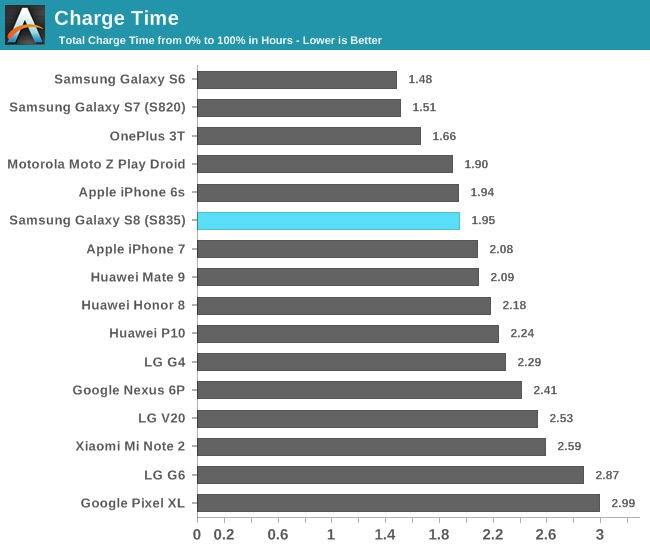
The Galaxy S8 comes with Samsung’s Adaptive Fast Charging technology along with both WPC and PMA wireless charging. Unlike some companies, such as Huawei and Motorola, that are pulling more than 20W of power at the battery, Samsung remains a bit more conservative. The included wall charger is rated for 5V/2A (10W) and 9V/1.67A (15W) operation—same as the Galaxy S7—which translates to a peak of 9.3W at the battery when charging with the screen off. Turning the screen on reduces the peak charging power to just 4.3W, so the S8 will not charge nearly as fast while you are using it.
The peak charging period lasts for 1 hour and 9 minutes before ramping down exponentially. This gets the S8 to 25% in 21 minutes and 50% in 42 minutes, very similar to the LG G6 and its almost 10% larger battery, which gets to 25% in 25 minutes and 50% in 46 minutes; however, the S8 is fully charged in just under 2 hours where the G6 takes 2 hours and 52 minutes. As another point of comparison, Huawei’s Mate 9, which has a much larger 4000 mAh battery, pulls up to 20.2W at the battery and reaches 25% capacity in about 12.5 minutes, 50% in about 25.5 minutes, and 100% in 2 hours and 5 minutes.


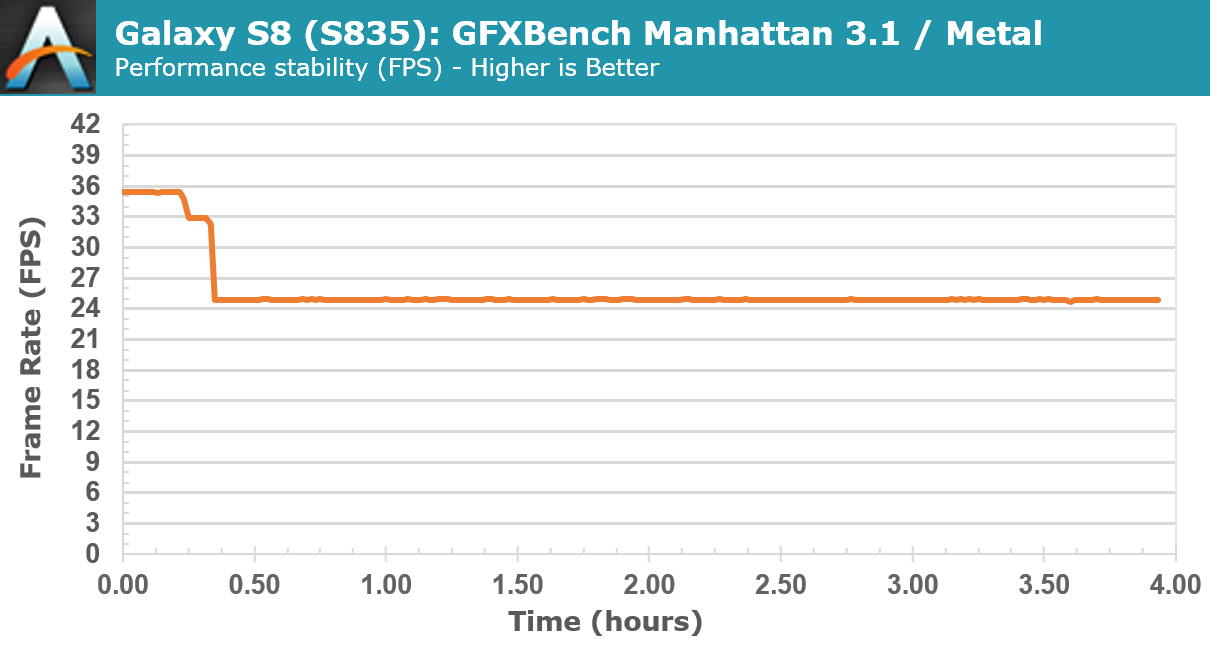
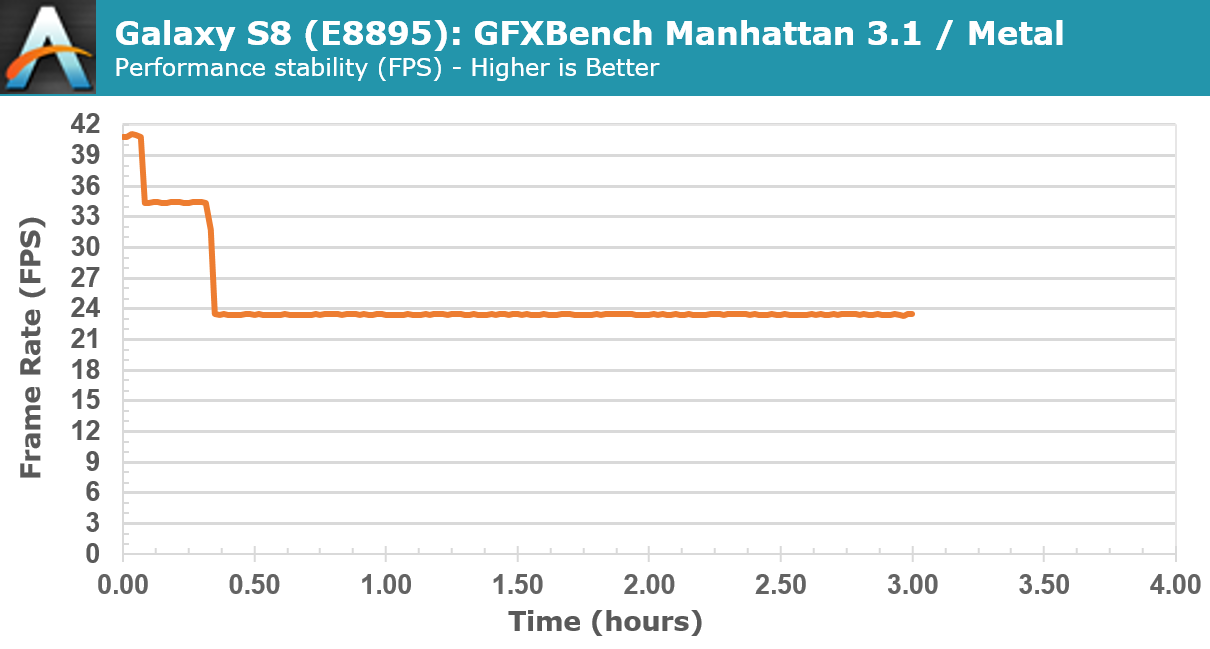
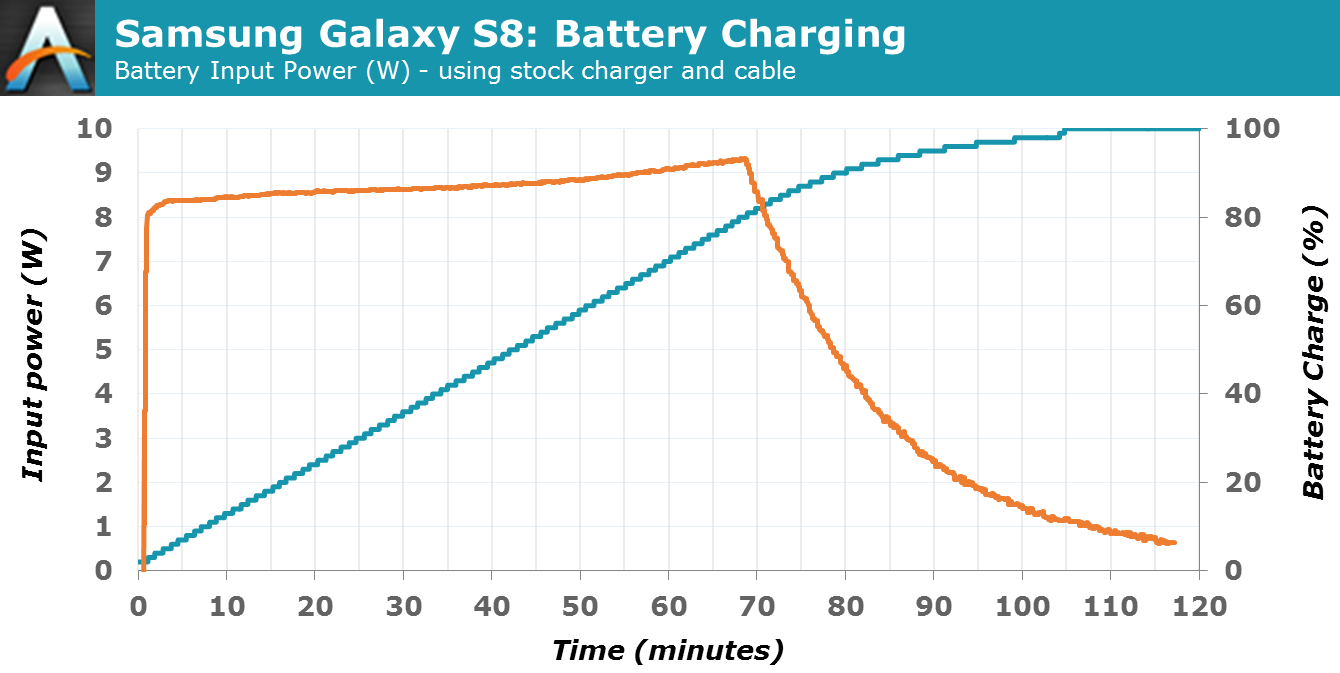








137 Comments
View All Comments
goatfajitas - Friday, July 28, 2017 - link
/edit - buy what suits youzodiacfml - Friday, July 28, 2017 - link
It is not that big. The "taller" aspect ratio exaggerates the diagonal. To the article, the 10nm SoC now seems more valuable than benchmarks/reviews I've seen from other sites. Since the Pixel is going to be expensive, taller, no storage expansion and without a headphone jack, I have no ideal phone yet this year. The Mi Mix 2 or the LG V30 might.philehidiot - Saturday, July 29, 2017 - link
Just as a side point, I went from a HTC M9 to an S8. I tried and tested the S8 and S8+. Bear in mind I have small hands to the point where I also pack a pair of socks to compensate. If you're American or not quite so crude that means I prefer a 9mm to a .45. I found the elongated screen of the S8 to be just about tolerable and the advantages for multitasking do outweigh the occasional situation where I need to reach the far end of the screen and can't do it. I suspect most people with normal hands will find the S8 to be perfectly fine from a usability standpoint. Certainly the S8+ I would strongly recommend you try a live model before you buy and perhaps consider waiting for the new Note if big screens are your bag.As for the carrying something that big you haven't heard the worst of it. It's well built - teardowns show this. Equally it's still made of glass for crying out loud. You NEED a case (and what's the point in making something so aesthetically amazing when you have to cover it??!!) and not a light one either. I have a leather fold out case which allows me to watch stuff on the phone at an angle and also takes some cards. Interestingly, it has two magnets right next to where the cards live. I got locked out of my hotel room due to this. Regardless, the necessary beef and size of case required to protect such a fragile device means the size is doubled. If HTC had continued down the metal line I'd have gone with them but it's all about bloody glass these days and I'm sick of it.
Tttimothy2355 - Friday, July 28, 2017 - link
Apple stocks galaxy awesomesyxbit - Friday, July 28, 2017 - link
>>"Our initial look at Snapdragon 835 revealed that its Kryo 280 performance cores are loosely based on ARM’s Cortex-A73 while the efficiency cores are loosely based on the Cortex-A53"Why would you write such a blatant lie. It's not LOOSELY based at all. It's >95% the same chip. QCOM have made minor tweaks just to be able to market it as their own design.
tipoo - Friday, July 28, 2017 - link
Where would the A10 fall on the ratio/GHz chart I wonder?http://images.anandtech.com/graphs/graph11540/sams...
name99 - Friday, July 28, 2017 - link
We can guess.You can see the A9 results here:
http://www.anandtech.com/show/9686/the-apple-iphon...
Eyeballing it, they are on average about 1.5x the current A73 results.
A10 results are about 50% faster again, while running at the same frequency as the CPUs referenced in the article, so basically about twice the IPC of the current A73 crop of champions.
One thing that stands out in comparing the SPEC results across all these devices is the massive jump in 175.vpr. A9 (which, like I said, is at around 1.5x for most results) has a value of 2017. This is about in line with what we see for Snapdragon 821. Then we get these massively (2x larger than I'd expect) scores for the other high-end ARM cores.
My guess is that something changed in the compiler in the past year or so. (Since the article doesn't say whether gcc or llvm was used, I can't investigate further.) My guess is likewise that this wasn't something nefarious, some "cheat" to make SPEC results look better --- no-one cares about SPEC2000 on ARM64 anyway --- but rather some general improvement in the compiler (perhaps loop unrolling/data placement, but most likely autovectorization) that managed to MASSIVELY improve ARM64 performance on this particular piece of code.
Presumably (if the change is in LLVM...) Apple picks up the same improvement, but sadly we never got to see the A10 SPEC results. Maybe A11?
So summary
- Apple's IPC seems to now be at around 2x ARM competitors for most purposes. (It's at around 1.25x Intel's; but to be fair Intel can clock higher; but to be fair Intel uses more juice)
- something interesting happened to 175.vpr on ARM64 in the past year or so, and if anyone knows, they should speak up!
Nullify - Saturday, July 29, 2017 - link
I was hoping for Anand to do a deep dive on the A10. Perhaps they're saving it for the A11? Should be the first ARM core in the world to break 4,000 single core on Geekbench, making it a full 2X faster than the 8895 or 835. It's truly amazing how much further ahead Apple is.tuxRoller - Saturday, July 29, 2017 - link
How big are those some cores, again?It's not like this is magic, and these companies know his to make very high IPC if you don't care about cost. Apple has built a massive core, and they pay the price in silicon.
ARM, and most of their licensees, are optimizing for silicon area efficiency, not absolute performance.
http://cdn.wccftech.com/wp-content/uploads/2016/10...
Meteor2 - Saturday, July 29, 2017 - link
I think that, as alluded to above, Android and iOS are diverging so much that there's little point comparing Apple IPC to ARM or whoever, you may as well compare it to Power or SPARC.